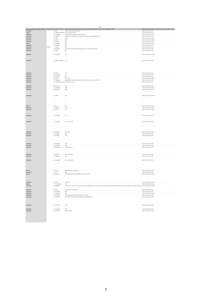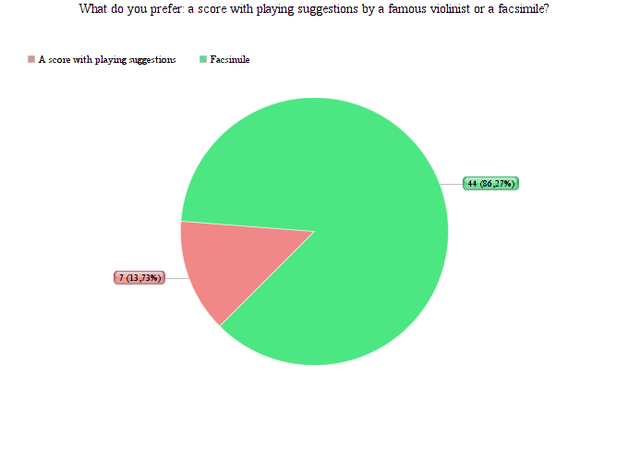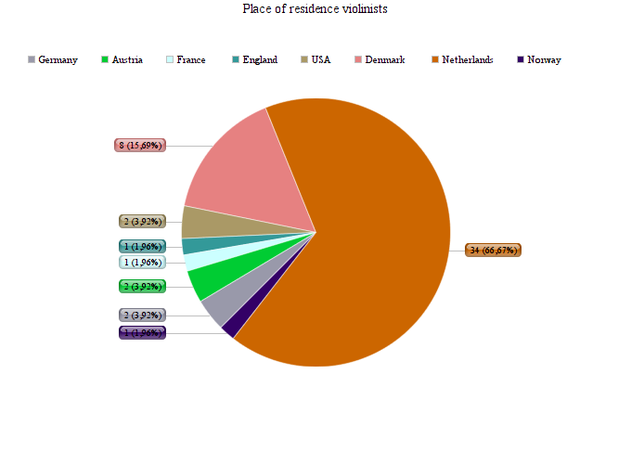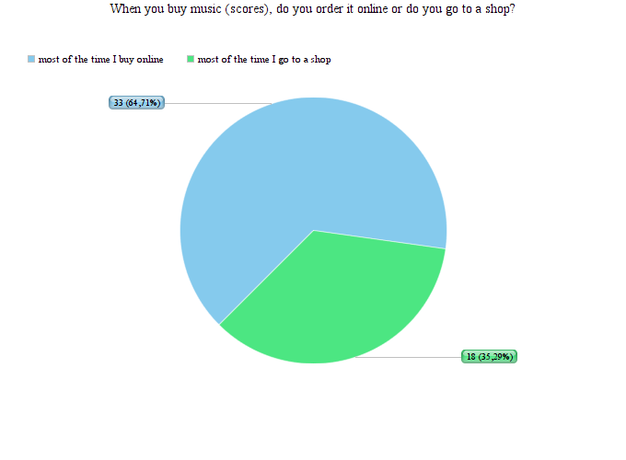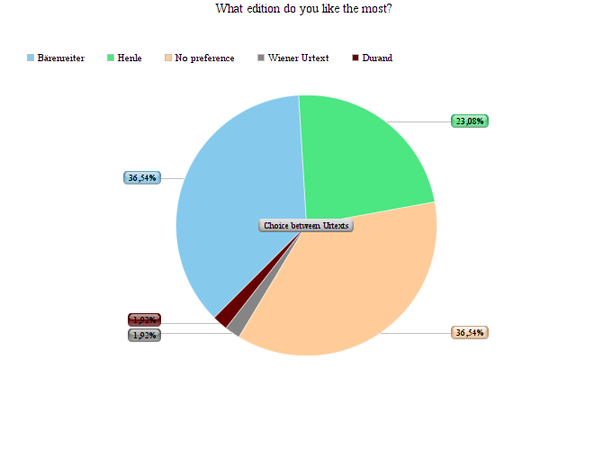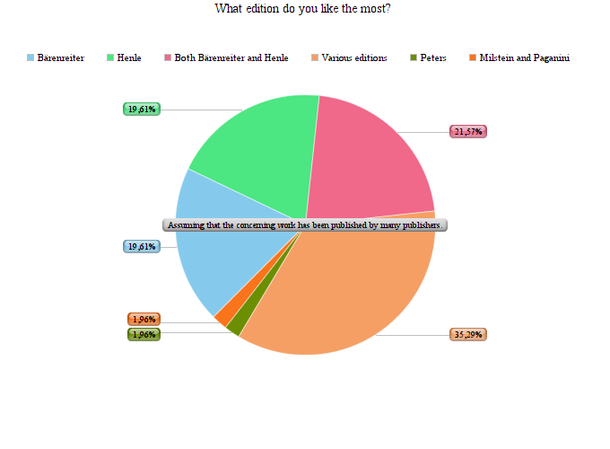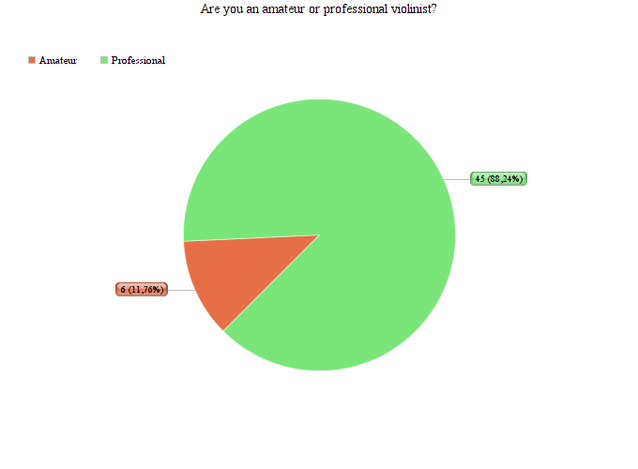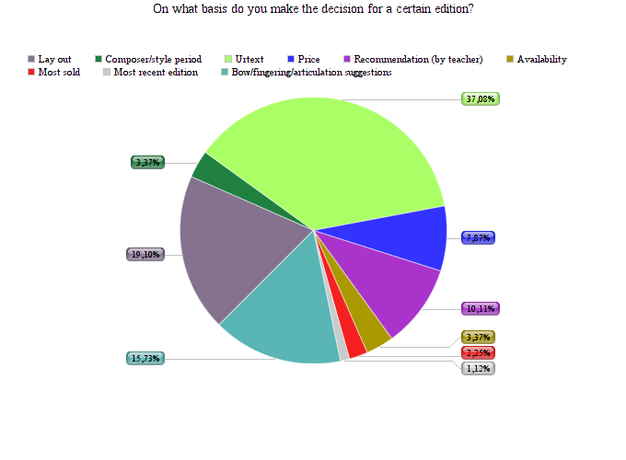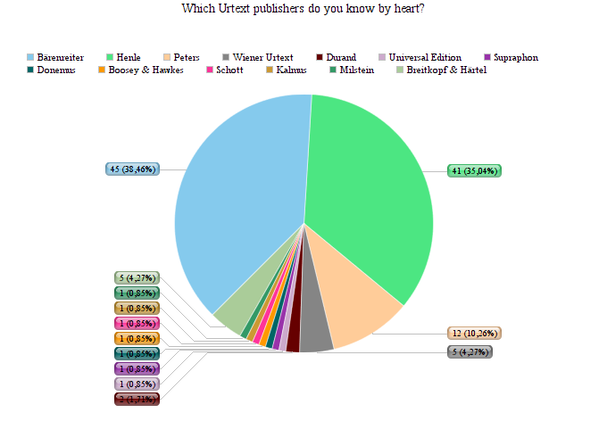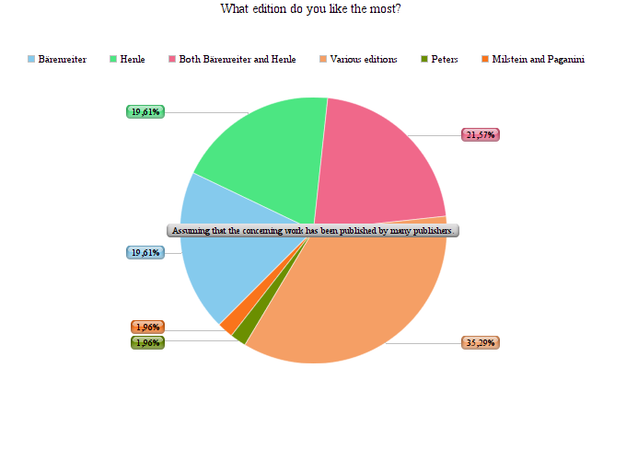An interesting question was the question “Which Urtext publishers do you know by heart?”. This question gives an idea about which publishers the violinists know or heard from. In total 11 publishers are mentioned. A lot of them are indeed Urtext publishers or do at least have an Urtext line in their assortment but also a few names have nothing to do with Urtexts. Again, Bärenreiter and Henle are the most well-known. Bärenreiter had a few votes more than Henle. Peters is more often named than Wiener Urtext although Peters just started with their Urtext line. Breitkopf is also less known as an Urtext publisher. At the bottom in this question, there are a few big publishing houses that are named just one time, for example Durand, Schott and Universal Edition.
The last question is a continuation of the previous question. The previous question was about naming publishers you know by heart. This question is again “What edition do you like the most?” as was the first question but now referring to the named Urtexts. So this last question concerns only Urtexts where the first question concerned all editions. Notable is that the balance between Bärenreiter and Henle is not completely equal anymore. This question shows that more people have the tendency to prefer a Bärenreiter. Bärenreiter and ‘no preference’ are both chosen 37 % where Henle was chosen only 23 %. Durand and Wiener Urtext were chosen just once and Peters and Breitkopf did not appear in the preference at all.
The results of this questionnaire give an insight in the habits of violinists from their own perspective. To give another point of view, an interview has taken place with one of the employees of Broekmans & van Poppel, the main major sheet music retail shop in The Netherlands, with shops in Badhoevedorp (Amsterdam) and Utrecht.
Most violinists who are actually buying a score do this most of the time online (65 %). That means that still 35 % goes to a music store to buy their scores. Linking this outcome to the outcome that lay-out has been regarded as the second most important motive to go for an edition, it is fascinating (and puzzling) how many people just buy the music online. It is much more difficult to compare editions on their lay-out and binding or user-friendliness on the web, where sometimes only the first page is shown as an example, than when you can see and feel the full scores in an actual shop.
Interesting to see are the reasons that were mentioned prompting the violinists’ decision for a specific edition. Being Urtext is by far the most important consideration (37 %). Second most important ground is the lay-out and third reason is the playing suggestions. Striking is that in general the price has not been mentioned that often as a consideration.
From the previous answers to the following question it shows that the historical correctness is regarded as very important: “What do you prefer: a score with playing suggestions by a famous violinist or a facsimile?” A remarkable 86 % chose the facsimile.
Regarding the historical correctness as an important reason to choose for an edition, it is interesting to see how many people regularly pick their scores from free (online) sources where historical background is much more difficult to verify. Most of the violinists do buy their scores but also use the free online access to many scores on the web (59 %). 10 % is using mainly free online sources to pick their editions. It seems that in practise ‘being Urtext’ is perhaps a bit less important compared to accessibility, availability and price (Urtext editions are not available for free at online sources) than the mentioning of this fact in the questionnaire suggests.
On what basis do violinists choose an edition to play from?
In the previous chapters the emphasis was on the publishers and their editions. The publishers offer certain products the musicians can choose from. Their products are also adapting to the wishes of the buyers as Henle mentioned in the survey for publishers. So, by doing a questionnaire for violinists the idea was to survey the habits and wishes of violinists when searching for an edition and to see if the outcome connects to the publisher's ideas.
The questionnaire was spread on Facebook and by email during the summer of 2017. 51 violinists filled out the questionnaire (scroll down to see all results of the questionnaire in PDF). The average age of the violinists who filled out the questionnaire is 27,6 years. The rest of the outcomes are shown below in the pie diagrams.
Six violinists who filled out the questionnaire are amateur, the rest is professional. The average age of the amateurs is almost the same as the average of everyone: 26,5 for the amateurs versus 26,7 for everyone. The pie diagrams show us the results of everyone because six amateurs are not representable for all the amateurs who play the violin. Besides there are no spectacular differences between the amateurs and professionals according to this survey. However, there are a few results that attract the attention: five out of six of the amateurs prefer to buy in a shop and not online, and also price and availability is more important for the amateurs than for the professionals. All amateurs prefer a facsimile in comparison with an edition with playing suggestions.
Almost all violinists are currently living in Europe, just two violinists live in the United States.
Which publishers are the most popular with violinists?
We sell mostly Urtext editions. It depends a bit on the repertoire because not every publisher has the same composers or works in their collection. Henle and Bärenreiter are the most popular. However, when there is a work published by both Henle and Bärenreiter we see a small tendency towards the Bärenreiter because they offer two violin parts: one without any suggestions of fingerings, bowings and articulation and one with suggestions by a violinist.
On what basis do violinists make their decision for a certain edition?
We see a lot that people make a decision based on the price. It is assumed that the editions they can choose from are good, talking about the Urtexts in general. So they heard from other musicians or teachers which edition should be bought.
On what basis do you (Broekmans & van Poppel) make the choice what you have in stock?
We can order almost everything actually but in practise we have a lot of Henle and Bärenreiter.
Are there any publishers that don't sell well here in the Netherlands?
Yes, there are publishers that are not selling here in the Netherlands. Mainly Russian editions are a good example for this. In America you can buy Russian editions but because of copyrights we can't sell them here. Boosey (publisher) has the rights to copy Russian editions and sell them under their name but they are not allowed to modify anything about the lay-out or with regard to musical annotations.
What shifts in the world of publishers can you notice?
Peters is also more focused on Urtext editions. Those are much better than the old Peters editions we still have in our memory. A few decades ago Peters was one of the most popular publishers among musicians. It is also one of the oldest publishing houses there is. They kept their way of editing because for a long time musicians where used to those editions. Nowadays we are more used to Urtext editions and Peters just started to follow this tendency. Another thing is that Bärenreiter started a few years ago with editions of the composer Beethoven. They didn't have him in their collection before, so musicians now have more choice when it comes to Beethoven.
Is there a development in quality of the products from publishers through the years?
Yes, the quality is much better now. The printing procedure made a big improvement as well as the readability and user-friendliness. Also bindings are in general much better so the scores last much longer.
How is your relation with publishers?
It is less personal than it used to be. Before we used the internet, publishers used to send a representative to show their new or revised editions. Now they send a newsletter by email with all the newest products they sell and quite often they send a few editions so we can show it to our customers. We as a seller are the intermediary between our customers and the publishers. So when there are comments about a specific edition we usually communicate that with the publishers. Most of the publishers take criticism seriously, although I never saw that they immediately changed something about an edition. Naturally, we are not the only ones that have contact with the publishers, so it is understandable that they don't change all the time with every comment they receive.
The internet has become a more important platform to sell your products. What do you think about that?
The last few years we sold already more and more on the web. We had to invest in the findability of our website to reach our customers. Our shop in the city centre was not the biggest selling point anymore and it was too expensive to stay there. We moved to Badhoevedorp which is on the outskirts of Amsterdam. Of course it isn’t as easy to reach as the place we used to have, but we notice that customers are getting used to that: when they have come here, they come more often. A lot of our customers like also to snoop around in our big collection of second hand music/scores and for that you should visit us in Badhoevedorp!
What are the trends of customers?
As I said people buy much more online. It is cheaper and that is something we have to deal with. Now we sell more online: people see a product on the website and compare it with other products or the same product on other websites. People have the tendency to just look at the price and what happens is that people buy for example a pocket score (cheaper) and find out when they have it at home that it is too small to read from and that they actually wanted a normal score which is more expensive. Now they have to send it back to us and we have to send a new score which takes a lot of time. This would have happened much less in a actual shop where people can see with their own eyes the scores before they buy them.
How will the future be for a shop like Broekmans& Van Poppel?
Nowadays, we are facing more than ever the challenge to move with the times. Our biggest challenge will be to keep the group of people who still wants a printed score interested in our shop and our expertise. For now, publishers still need us as a port for their sales market here in the Netherlands. But publishers are investing too in their webshops and findability on the web. In the near future we could be the port for publishers who are digitalizing their products so we can sell their scores as downloads. Henle is taking a step further with their Henle App so musicians can have all the music on a tablet. There is still a generation of musicians who grew up with actual paper scores but the new generation is used much more to do a lot/everything with tablets. Also the userfriendliness of the tablets and the music apps are developing in such a way that it is really usable during concerts and rehearsals. Of course there will always be a group of people that prefers music on high quality paper to playing from a tablet, but I think this group will be too small to really flourish as a music shop.
With special thanks to:
Broekmans & van Poppel B.V.
Badhoevelaan 78
1171DE Badhoevedorp
broekmans.com
Summary
Combining the outcome from both the questionnaire and the interview with Broekmans there are a few conclusions that can be drawn: indeed, both Henle and Bärenreiter are the most popular Urtext editions among violinists. Furthermore, a lot of the musicians order their scores online, without the possibility to have a good look at the different editions. A most striking difference in the outcome of the questionnaire with both the violinists and publishers against the experience of Broekmans in the interview is regarding the importance of the price. In the previous chapter, concerning the publishers, it is shown in their questionnaire that ‘price’ is the lowest priority with almost everyone. This fits in the outcome of the violinists concerning the question “On what basis do you make a decision for a certain edition?” Price was just named 7,87% of all reasons to choose a certain edition. However, at Broekmans they experience the complete opposite: most decisions are made based on price. Even more so now, when they sell mostly online. At Broekmans they get packages sent retour because the wrong score had been ordered. The most common mistake is the difference between a study score and a full score. The study scores are pocket formats and difficult to play from but much cheaper. The full scores are made to play from but much more expensive. Apparently this goes wrong quite often when music has been ordered online. But also when people are in the actual shop. The common reason to buy a certain editon is: Urtext (yes/no) and then the price.
The first question that is about editions is: “What edition do you like most - in case the concerning work has been published by more than one publisher?”
The answers show that both Bärenreiter and Henle are the most popular editions. Separate from each other these two publishers are named 19,61 %. 21,57 % named both bärenreiter and Henle. Adding up these numbers, it means that in total 61 % would like to have an Urtext edition by Bärenreiter or Henle. The piece ‘various editions’ means that the violinists did not mention a specific publisher and that they depend their decisions on various factors.
